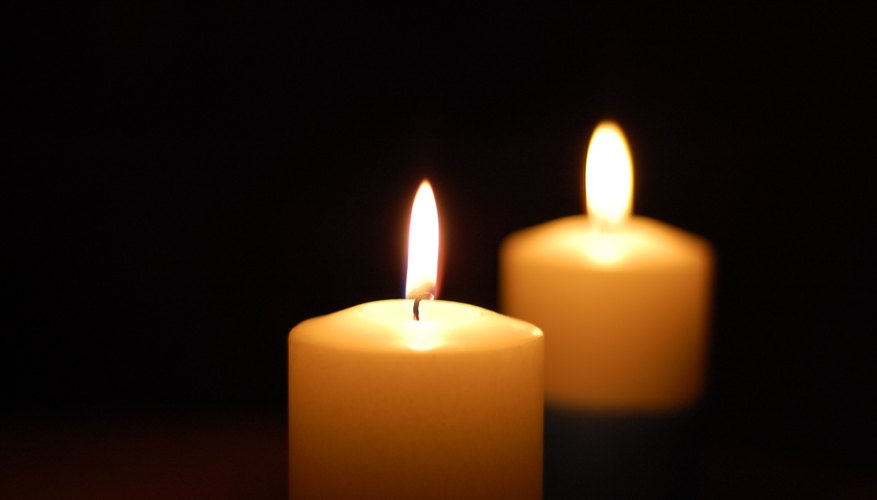Too often, good candles are thrown out by the user instead of repairing them so that they work well. Salvage your candles by fixing the candle wick.
Diagnose the problem. If the wick is getting a black ball on the end, and giving off sooty smoke, the wick is too thick for the type of fuel. If the wick is melting a puddle in the middle of the candle that is too small, the wick is too thin. If the wick is nowhere to be seen, it may be trimmed too short, or have been pulled off completely. If the wick will not light at all, the wick may be wet.
- Too often, good candles are thrown out by the user instead of repairing them so that they work well.
- If the wick is melting a puddle in the middle of the candle that is too small, the wick is too thin.
In cases where the wick is the wrong size, pull the wick out. You may need to pull a small metal plate or a sticker off of the bottom to get at the wick. Gingerly pull at the wick and see if it gives without breaking. If the wick won't come out, take a straight length of coat hanger, and heat it up.
In a well-ventilated room, hold the wick in a pair of needle nose pliers. Use the resulting gap at the tip of the pliers to guide the hot coat hanger down into the candle, while pulling up on the wick. When the wick comes out, you should leave the hanger in until it cools. Twist the hanger before the wax completely hardens to pull it out, leaving a long hole.
- In cases where the wick is the wrong size, pull the wick out.
- When the wick comes out, you should leave the hanger in until it cools.
When the hanger is cool, clean the end of the hanger off to remove the wax. Glue the tip of the new wick to the end of the hanger, and heat up the hanger again with the wick away from the hanger. Place the tip of the hanger into the same hole from which the old wick was removed. Use the hole to guide the hot hanger as you push it up the hole from underneath the candle.
- When the hanger is cool, clean the end of the hanger off to remove the wax.
- Place the tip of the hanger into the same hole from which the old wick was removed.
At the end of the hole, with the wick sticking out above the candle, cut the end that is attached to the tip of the coat hanger. Withdraw the coat hanger, and let melted wax flow into the hole that the hanger made. Pull the wick completely through before the wax cools completely.Trim the wick to 1/4 inch above the surface of the candle top.
If the wick was trimmed too short, trim down the candle to match. Digging around the wick will be sufficient to expose the tip enough to use, unless the candle melts and smothers the flame. If this is the case, you will have to dig out a wider area around the candle wick before lighting it.
- If the wick was trimmed too short, trim down the candle to match.
- Digging around the wick will be sufficient to expose the tip enough to use, unless the candle melts and smothers the flame.
If the wick is wet, scrape off as much wax as you can from the end of the candle. Remove the moisture as best as you can by squeezing the exposed wick between paper towels. Place the candle in a dry location where the candle will not melt for a few days, repeatedly squeezing the wick in a dry piece of paper towel. Try lighting the candle again, and if this does not work, replace the wick.
TIP
If the coat hanger can't stay hot long enough to penetrate the candle, attach the hanger to a soldering iron with very small metal pipe clamps when the metal is cool again. If you have a candle in a jar, and can't get at the bottom of the candle, go in from the top, melting the area to which you need access, and then remelting the wax back to the same level.
WARNING
Wear goggles. The candle can start on fire from the heat of the coat hanger. The candle can melt, and may change appearance after using these procedures. Do not touch the heated metal without proper protection. Wax can splatter. Wax is flammable. Burning/melting wax can create fumes that require proper ventilation. These procedures will void warranties and guarantees that the vendor might otherwise offer. Altering the candle may change the features of the candle, including those used for safety. Use a gentle clamp to steady your candle for safety.
